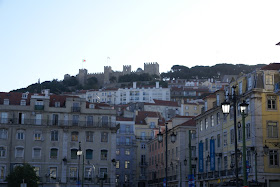
We rented a car In Le Havre, France in order to visit the Normandy invasion beaches and the Bayeaux Tapestry. More on the car adventure below.
Normandy is quite beautiful. Le Havre is at the mouth of the Seine River. One crosses the river on a beautiful suspension bridge called the Normandy Bridge. This leads to the picturesque town of Honfleur, little damaged in WWII. It is shown in some early French impression paintings, one of which by Claude Monet we saw in Lisbon. After leaving Honfleur we chose to drive to the the landing beaches along a road that is right next to the sea. We passed through picturesque villages, apple orchards, pastures with lots of white Charolaise cattle and an occasional chateau.
Then came the landing beaches, the first one being Sword in the British sector. The terrain here is quite flat and the houses are literally on the edge of the beach. I remember combat footage of this sector and seeing the British soldiers leaving their landing craft and walking up to and past those houses. Whether they are the same houses I can’t say but they are similar and their position is the same. We continued along the coast road, stopping at an old German gun emplacement and a place where there are still some old boats or artificial harbor present, including Juno and Gold beaches, attacked by British and Canadian forces.



Then we came to Omaha beach, the first of the two landing beaches of the Americans. Omaha beach has a bluff behind it and is a narrow strip of sand some 30 yards wide at least at the time we were there. I think it is wider by quite a bit at low tide. Those poor devils jumped out of landing craft, sloshed through cold water to and up the beach to the ravines and bluff and up all under withering fire. Most of them were 18-19 year old young men, never under fire before, who had not yet begun to live. The Army used mostly green troops for the initial assault because they were afraid combat veterans would tell them to get stuffed.


On top of the bluff a few hundred yards from the beach is the American cemetery, with about 9800 American troops buried under rows and rows of crosses and Stars of David. The markers that said “Unknown” were the most moving. Probably an 18 year old, barely out of high school, never knew the joy of love, never had a chance to experience children of his own, further education or the other wonderful things that make up human life.


After Omaha Beach we drove to the town of Bayeaux, just a few miles inland. After William the Conqueror mounted his successful invasion of England in 1066 AD, a tapestry was made in about 1075 telling the entire story. This tapestry is over 100 feet long and about 3 feet high, embroidered on linen. It is amazing; it is still intact and in good shape after 1000 years. It is housed in a special museum in Bayeaux. Below is a photo of Bayeaux cathedral and a medieval mill in Bayeaux.


I must tell you about our rental car experience. Since my French is limited to “merci” and “merde”, when we tracked down a rental car agency that had an office at the dock, we got our daughter , Frau Magister, who was studying in Strasbourg at the time, to call them. She did this and included a GPS unit programmed in English. This went off without a hitch and on our arrival a nice little car awaited. We went over the car and the GPS with the agent and then asked how we got to the Normandy Bridge. Big mistake. We started off following his directions, and very soon “Sally” the GPS chick said “Make a U-turn as soon as possible!” We of course didn’t and soon she was saying things like “Turn right here”, and more “Make a U-turn as soon as possible!” Eventually we stopped and asked for directions to the Bridge. We followed the directions and soon saw the bridge. About this time Sally became sullen and refused to talk. Her map function still worked plus we had a good paper map so we were alright.
When we left Bayeaux to return we decided to give Sally another shot. I punched “home” on the GPS and presto! Sally started speaking. She said useful things like “take the second exit on the roundabout” or “take the exit to your right in 400 meters”. There is a perfectly good tollway from Bayeaux to the Normandy Bridge but Sally would have none of it. She would once or twice put us on it for a short ways and then get us off as soon as possible. One of these secondary roads was a one lane dirt cow path between two highways. We followed her faithfully and soon were in Le Havre. She had us turn at almost every intersection until we were right downtown, at which point she announced “Home” and quit. I saw no port, no dock, no 1300 passenger ship. I was about to panic when Cheryl spotted a tour bus go by with “Rotterdam”, the name of our ship, on it. We followed it around a few corners and saw the ship! Yeah!
Don’t tell me computers and GPS units aren’t sentient beings.





























